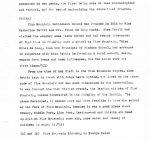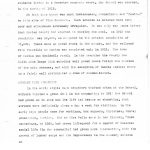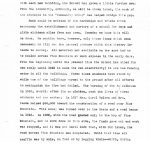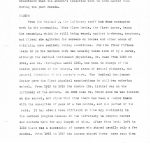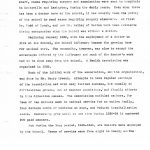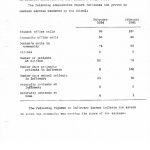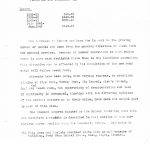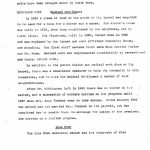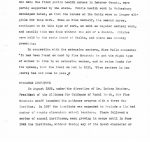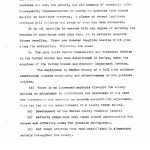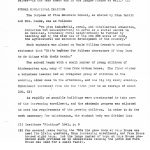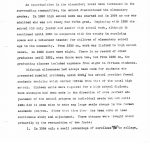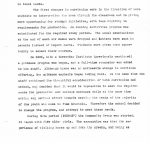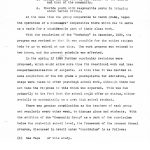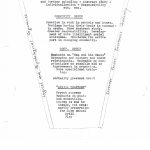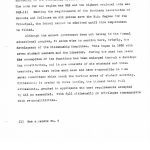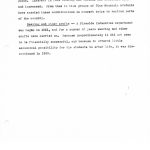Pine Mountain Settlement School
Series 07: Directors – Glyn Morris
GLYN MORRIS 1942 STUDY & RECOMMENDATIONS II HISTORY
TAGS: Glyn Morris Study & Recommendations II History; Glyn Morris; founding of PMSS; community; demographics; road building; fires; CCC labor; health services; Infirmary; nurses; doctors; Line Fork Medical Settlement; Harlan, KY; Health Association; income of medical services; clinics; Community Group; Medical Settlement at Big Laurel; Anna Pishza ; Guidance Institute; education; academic programs; Consumers’ Cooperative Store; Citizenship Committee; conservation of traditions; Fireside Industries; institutional history;
GALLERY: Glyn Morris Study & Recommendations II History
- morris_study_02 (13)
- morris_study_02 (14)
- morris_study_02 (15)
- morris_study_02 (16)
- morris_study_02 (17)
- morris_study_02 (18)
- morris_study_02 (19)
- morris_study_02 (19a)
- morris_study_02 (20)
- morris_study_02 (21)
- morris_study_02 (22)
- morris_study_02 (23)
- morris_study_02 (24)
- morris_study_02 (25)
- morris_study_02 (26)
- morris_study_02 (27)
- morris_study_02 (28)
TRANSCRIPTIONS: Glyn Morris Study & Recommendations II History
[Slightly edited.]
[morris_study_02-13-1.jpg]
13.
II
HISTORY OF PINE MOUNTAIN SETTLEMENT SCHOOL
For purposes of convenience, the history of the School will be presented in two parts, the first being more or less chronological and factual, and the second emphasizing the educational program.
GENERAL
Pine Mountain Settlement School was founded in 1913 by Miss Katherine Pettit and Mrs. Ethel de Long Zande. Miss Pettit had visited the country some years before and had become interested at that time in founding such a school as Pine Mountain. “Miss Ethel de Long, then the Principal of Hindman School, had arranged to cooperate with Miss Pettit in founding a rural school, where, remote from towns and town influences, the two could work out their ideas.”(1)
From the time of her visit to the Pine Mountain region, Miss Pettit kept in touch with Judge Lewis Lyttle, who lived on the other side of Pine Mountain but was much interested in the undertaking. It was through him that William Creech, the leading citizen of Pine Mountain, became interested in the founding of the School. “As plans developed, it seemed more and more feasible to have the School at the foot of Pine Mountain, because it was a good place where Greasy, Middle Fork, Line Fork, Leatherwood and Cutshin all head up against Pine Mountain; pure air, pure water and plenty of children to enjoy it.”(2)
(1) and (2) Pine Mountain History by Evelyn Wells.
[morris_study_02-14.jpg]
14.
Further light on the choice of this particular spot was recently thrown on the subject by Judge Lyttle, who mentioned that Miss Pettit had wanted to be “as far away from a railroad as possible.”
Thus, with 108 acres of land contributed by William Creech, local contributions of lumber and labor, with a handful of workers and students living in a deserted mountain store, the School was started, in the spring of 1913.
At that time there was much lawlessness, moonshining and “feuding’ on this side of Pine Mountain. Such schools as existed were very poor and attendance extremely irregular. It was only two years before that Harlan County had started to develop its coal. In 1910 the population was 16,000, as compared to the present [1942] population of 75,000. There were no paved roads in the county, and the railroad from Pineville to Harlan was completed only in 1911. The town of Harlan was decidedly rural. In the meantime the County has built nine large high schools; well-paved roads follow the courses of the main streams, and with the exception of remote hollows there is a fairly well-articulated system of communication.
CONTACT WITH COMMUNITY
In the early simple days, neighbors visited often at the School, workers visited a great deal in the community; by 1917 the School had grown so in size and its life had become so absorbing, that workers were definitely given a day a week for visiting. In the early days, people came for workings, box suppers, Christmas, Sunday preachings, parties. But as Miss Wells says in her History, “Such gatherings, by 1928, had grown infrequent for a number of reasons: social life (in the community) had grown more interesting, with the growth of lumber camps and the improvement in the country schools…
[morris_study_02-15.jpg]
15.
…and in living conditions; people started to go across the mountain for their entertainment; the life of Pine Mountain had grown so much that perhaps our neighbors did not feel so well acquainted any more.” The growth of the School inevitably isolated it from the community; with every modern improvement that has been added, and with each new building, the School has grown a little further away from the community, although, as will be shown later, the work of the students in the “Community Group” has helped bridge this gap.
Much could be written of the hardships and trials which accompany the establishment and nurture of a school for boys and girls eighteen miles from any town. Someday we hope this will be done. We mention here, however, only those items which seem necessary to fill out the general picture which this history intends to convey. All material not available on the spot had to be hauled across Pine Mountain at much expense in the early days. From the beginning until the present time the School has mined its own coal; until 1942 it made its own electricity; it now has running water in all the buildings. Three times students have stood by while one of the buildings burned to the ground after all efforts to extinguish the fire had failed. The burning of the Schoolhouse in 1918, shortly after its completion, cost the lives of three students and one worker. In 1917 Mrs. Carl Holton and Mrs. Zande raised $50,000 toward the construction of a road over Pine Mountain. This money was turned over to the State and a road begun in 1918. In 1922, with the road graded only to the top of Pine Mountain, and no work done on this side, the funds gave out and work was stopped, and it was not until 1935 that, with CCC labor, the road across Pine Mountain was completed. Until that time all traffic was by mule, on foot or by logging train — which, during…
[morris_study_02-16.jpg]
…the years following 1929 ran sometimes only once in two weeks. Occasionally a venturesome car came over the wagon road. With the removal of CCC camps from the area, the road is becoming increasingly worse, and with completion of a new state highway across Pine Mountain ten miles west of the School, there is some likelihood that the School’s isolation will be more marked than during the past decade.
HEALTH
From the beginning, the Infirmary staff has done extensive work in the community. Miss Clara Davis, the first nurse, began the campaign, which is still being waged, against hookworm, trachoma, and flies; she agitated for screens on houses and other means of obtaining more sanitary living conditions. For the first fifteen years or so the medical work was usually taken care of by a nurse, although the [Line Fork] Medical Settlement physician, Dr. [Grace] Huse from 1920 to 1924, and Dr. [Alfreda] Withington until 1931, has been charge of the health policies of the School, the cases of actual sickness, and general direction of the nurse’s work. The Medical Settlement doctor gave the first physical examinations to children entering school. From 1916 to 1918 the doctor (Dr. [Abby] Little) was at the Infirmary at the School. In 1932 when Dr. [Kenneth] Gould came he was located at the School, and since that time there has been a doctor here with the exception of gaps of a few months, and one period of two years. It has always been difficult to have any continuity in the medical program because of the difficulty in keeping nurses and doctors here for any length of time. After Miss Davis left in 1915 there was a succession of nurses who stayed usually only a few months. From 1921 to 1927 two nurses stayed three years each; then…
[morris_study_02-17.jpg]
17.
…there was further interruption, until Miss [Grace] Rood, the present nurse, who has been there since January 1937.
Whenever possible the nurse has had regular classes in nursing and hygiene. She has always been available for calls out into the country, when not needed in the School. When no doctor was on the staff, cases requiring surgery and examination were sent to hospitals in Louisville and Lexington, during the early years. Even when there has been a doctor here at the School, it has usually been the policy of the School to send cases requiring surgery elsewhere. At first Dr. Todd of Lynch, and now Dr. [Clark] Bailey of Harlan have been available during emergencies when the School was without a doctor.
Beginning January 1932, with the employment of a doctor to live at the School, the School Infirmary became the growing base for medical work. The community, however, was slow to accept the advantages offered by the Infirmary and much of the doctor’s work had to be done away from the School. A Health Association was organized in 1932.
Much of the initial work of the association, and the organization, was done by Mr. Henry Creech. Attempts to have regular meetings of the Association met with only limited success, due usually to difficulties growing out of weather conditions, and finally, efforts in this direction ceased. The Association entitled members, for fees of ten dollars each to medical service for an entire family, four dollars worth of medicine at cost, and reduced hospitalization costs. Membership grew until at one time during 1938-39 it numbered 200 paid members.
But during the long period, 1932-1941, six doctors were employed by the School. Terms of service were from eight to twenty months.
[morris_study_02-18.jpg]
18.
One left to be married, another for service in a foreign field, another felt the work too difficult because of his age and inability to travel over the countryside. The others went for a variety of reasons. Inability of the doctors, or their families, to adjust to an isolated institutional life played a large part.
| February 1934 | February 1941 | |
| Student office calls | 99 | 137 |
| Community office calls | 36 | 99 |
| Doctor’s calls in community | 74 | 58 |
| Clinics | 9 | 8 |
| Number of patients at clinics | 26 | 79 |
| Number days community patients in Infirmary |
0 | 135 |
| Number days School patients In Infirmary |
31? [51?] | 92 |
| Maternity patients at Infirmary | 0 | 5 |
| Maternity patients at home | 4 | 1 |
[morris_study_02-19.jpg]
19.
The following figures on Infirmary income indicate the extent to which the community has been meeting its share of the expense:
Expenses—————– Approx. $3,720
Average annual expense, 1932-1942
(salaries and supplies) (1)
Income
1932-33 ———————144.45
1939-40——————–1449.65
1940-41——————–2225.48
July 1941-Jan. 1942—-1441.45
The increase in income has been due in part to the growing number of people who came from the general direction of Beech Fork for medical service. Because of lumber operations in that region, there is more cash available there than in the immediate community. This situation may be affected by the completion of the new road which will follow Beech Fork.
Attempts have been made, with varying success, to establish clinics at Line Fork, Turkey Fork, Big Laurel, Alec’s Branch, Incline and Beech Fork, but uncertainty of transportation and lack of continuity in personnel, together with the differing opinions of the various doctors as to their value, have made the School give up most of this plan.
The present program adopted by the School involving work with the immediate community is described in that section of the curriculum survey dealing with the Community Group. Beginning in…
(1) This does not include overhead costs such as maintenance of building, food from Laurel House, heat, light, laundry.
[morris_study_02-19a.jpg]
19.
…1937, a small group of students, under the supervision of the nurse, made regular visits to homes in the community. The work was gradually extended to include the entire junior class, and the members of the group worked not only in homes, but in the district schools as well. There is much evidence to indicate that effective and profitable results have been brought about by their work.
EXTENSION WORK
Medical Settlement
In 1918 a piece of land at the mouth of Big Laurel was acquired to be used for a home for a doctor and a nurse. The doctor’s house was built in 1919, from logs contributed by the neighbors, and by their labor. The Playhouse, built in 1920, burned down in 1925 and was replaced by the larger and more efficient Community House, now standing. The first staff members there were Miss Harriet Butler and Dr. [Grace] Huse. Medical work was supplemented considerably by recreational and Sunday School work.
In addition to the public health and medical work done at Big Laurel, there was a consistent endeavor to help the community to help themselves, and to have the Medical Settlement a center of real neighborliness.
After Dr. [Alfreda] Withington left in 1931 there was no doctor at the center, and a succession of workers carried on the programs until 1937 when Mrs. Anna Pishzak came to take charge. Since January 1941 the School has not carried Mrs. Pishzak on its payroll but has permitted her to remain there in exchange for upkeep of the premises. She carries on a limited program.
Line Fork
The Line Fork extension center was the outgrowth of Miss…
[morris_study_02-20.jpg]
20.
…Marguerite Butler’s two-year piece of extension work on Line Fork. The land for the center was given by a coal and lumber company, the logs were contributed by the community, and the funds were raised by Miss [Angela] Melville in 1919. The first staff members were a teacher, a nurse and a social worker. The first two nurses, who were the first public health nurses in Letcher County, were partly supported by the state. Public health work in Whitesburg developed later, so that the nurses at the Cabin were no longer eligible for this work. Even so, Miss [Anne Ruth] Medcalf, the second nurse, continued to do this type of work, as well as regular medical work, and usually, this was done without the aid of a doctor. Clinics were held by the state Board of Health, and there was monthly preaching.
In connection with the extension centers, Miss Wells comments: “It has been found so hard by Pine Mountain to get the right type of worker to live in an extension center, and to raise funds for its upkeep, that the ideal we had in 1918, ‘Five centers in ten years,’ has not come to pass.
In August 1935, under the direction of Dr. Latham Hatcher, President of the Alliance for Guidance of Rural Youth, the Pine Mountain staff launched its guidance program with a three-day institute. In 1937 the institute was expanded to include a limited number of county elementary school teachers. There followed a series of annual institutes, each growing in scope until in June 1942 the Institute, without losing any of its local character or…
[morris_study_02-21.jpg]
21.
…identity, became the first week of a summer school session held under the auspices of the University of Kentucky, in Harlan County.
The Institute addresses itself to ways of helping youth, through understanding youth and the changing scene of which he is a part, and then organizing resources available to help him. This naturally involves not only the school but all aspects of community life. Consequently, representatives of community agencies have shared equally on Institute programs. A glance at recent Institute programs will indicate the scope of what has been attempted.
It is not possible to measure with any degree of accuracy the results of Institutes held thus far, or to estimate possible future benefits. There are however tangible results which give clues for evaluation. Following are some:
[*Bold font added by editors]
- The only rural Junior Counselling and Placement Service in the United States has been established in Harlan, under the auspices of the United States and Kentucky Employment Service.
- The employment by Harlan County of a full-time guidance coordinator ensures continuity and effectiveness to the guidance program.
- There is an increased emphasis throughout the county schools on adjustment of individuals and awareness of the need for information and training as regards occupational adjustment. This has led to the establishment of a county trade school.
- Development of the Harlan County Planning Council.
- Definite steps have been taken toward understanding the causes and effecting cures for juvenile delinquency.
- Hot lunch programs have been established in elementary schools throughout the county.
[morris_study_02-22.jpg]
22.
- Last but not least is “The steadily developing Institute itself, which provides annually a week when country-wide leadership assembles with state and national consultants, to study intensively how Harlan County young people can best be served and serve themselves — in the year ahead and in the longer future as well.”(1)
FORMAL EDUCATIONAL TRAINING
The purpose of Pine Mountain School, as stated by Miss Pettit and Mrs. Zande, was as follows:
“To give industrial, moral, and intellectual education, Christian but non-sectarian; to serve as a social centre in an isolated, intensely rural neighborhood; to further by teaching and by the wise use of its own 335 acres of land, the agricultural and economic development of the country.”
Much emphasis was placed on Uncle William Creech’s profound statement that “Hit’s better for folkses characters if they larn to do things with their hands.”
The School began with a small number of young children of kindergarten age, many of them from broken homes. The first winter a volunteer teacher had an irregular group of children in the morning, older ones in the afternoon, and one big boy every evening. Enrollment increased from six the first year to an average of about 100.(2)
As rapidly as possible buildings were constructed to take care of the increasing enrollment, and the academic program was adjusted to meet the requirements of the growing children. In order to do the work necessary for maintenance, the student body was divided into…
- Institute “Findings,” 1941, p. 3.
- For several years during the ‘30s the game room at Boys House was used for living quarters, thus increasing enrollment, and Farm House housed eight boys. But the large number of boys at Boys House presented such problems as to necessitate closing the porch, and Farm House was used for a small family.
[morris_study_02-23.jpg]
23.
…two sections, one going to school in the morning while the other section worked in the kitchen, on the farm, in the shop, etc. This order was reversed in the afternoon. The daily program included four hours of work, five hours of school and one and one-half hours of required study, from 6:30 to 8:00 P.M.
As opportunities in the elementary level were increased in the surrounding communities, the School discontinued the elementary grades. In 1920 high school work was started and in 1924 no one was admitted who was not ready for fifth grade. Beginning with 1930 the School did only junior and senior high school work, although it continued until 1936 to cooperate with the county in supplying space and a volunteer teacher for children of elementary school age in the community. From 1938 on, work was limited to high school level. In 1923 there were eight. There is no record of other graduates until 1931, when there were two, but from 1932 on, the graduating classes included anywhere from eight to fifteen students.
Although allowances had always been made for students who presented special problems, until 1934 the School provided formal academic training which varied little from that of the usual high school. Sixteen units were required for a high school diploma. Some attempts had been made in the direction of more perfect adjustment of the school program to individual needs but not until 1934 did it seem wise to make any large scale change in the formal academic program. Since that time there has been more or less continuous study and adjustment. These changes were brought about primarily by the recognition of two facts:
- In 1934 only a small percentage of enrollees went to college,…
[morris_study_02-24.jpg]
24.
…and the academic program following the traditional pattern was based on eventual college entrance. At the present (1940) however, a study of graduates shows 30% as having gone to college.
- Rapid changes in social and economic structure of Harlan and adjoining counties called for a type of training better adjusted to local needs.
The first changes in curriculum were in the direction of more emphasis on interpreting the area through the classroom and in giving more opportunity for student initiative, with less rigidity in requirements for graduation. An evening activities program was substituted for the required study period. The usual examinations at the end of each six weeks were dropped and letters were sent to parents instead of report cards. Students were given more opportunity to select their courses.
In 1935, with a three-day Institute (previously mentioned), a guidance program was begun and a full-time counselor was added to the staff. Although there was no noticeable change in curricula offering, the guidance emphasis began taking root. At the same time the staff continued its thoughtful consideration of both curriculum and method and decided that it would be impossible to meet the requirements for graduation and college entrance while at the same time making any serious effort towards meeting the needs of the majority of the youth who came to Pine Mountain. Therefore, the School decided to change its program, and attempt to meet these needs.
During this period (1936-37) the Community Group was started. It began with five older girls. The assumption was that the experience of visiting homes up and down the creeks, and being as…
[morris_study_02-25.jpg]
25.
…helpful as possible, under the supervision of the nurse, would serve among others the following useful purposes:(1)
- Give practical experience and bring more realism into the school program.
- Provide the community with a much-needed service.
- Bridge the gap between the culture of the School and that of the community.
- Provide youth with responsible parts in bringing about better living.
At the same time, the group comparable to tenth grade began the operation of a Consumers’ Cooperative Store which was to serve as a basis for a considerable part of their class work.
With the completion of the “Workshop” in December 1936, the program was revised so that it was possible for the entire student body to go to school at one time. The work program was reduced to two hours and the present schedule was effected.
In the spring of 1928 [handwritten notation: 39?] further curricular revisions were proposed, which would allow more time for vocational work and less compartmentalization of subjects. At this time it was decided to make completion of the 8th grade a prerequisite for admission, and steps were taken to offer post-high school work, although there has not been the response to this which was expected. This was due primarily to the fact that the School could offer no status, either socially or academically, to a post-high school student.
There was greater coordination as the teachers of each group met regularly every other week, to discuss plans and students. With the addition of the “Community Group” as a part of the curriculum below the post-high school level, the framework of the present formal program, discussed in detail under “Curriculum” is as follows:
- See Page [missing text] of this study.
[morris_study_02-26.jpg]
26.
[Words bordering top of page:] Broadening the Range of Activities and Choices
[Words bordering left side of page:] Logical and Psychological Sequences
[Words bordering right side of page:] Interest Factor Increases Gradually
[Text within above borders:]
SPECIALIZATION
More intensive preparation for occupation and further schooling — Abstract study — Individualization — Responsibility, etc., etc.
COMMUNITY GROUP
Practice in work in schools and homes. Problems having their basis in community needs. More abstract study. Greater responsibility. Development of more intelligent social attitudes. Provision for active part in changing community.
COOP. GROUP
Emphasis on “Man and His Needs.” Economics and history and their relationship. Emphasis on Coop principles as possible aid to improvement in mountains. More specialized training. Mortality greatest here?
“LIVING TOGETHER”
Tryout courses. Emphasis on minimum essentials. Course is end in itself, not necessarily preparation for more school. Drill. Play.
[morris_study_02-27.jpg]
27.
In 1940 the School was classified for the first time as a Grade A school by the Kentucky authorities. In 1939 it participated in making the criteria for evaluation of high schools under the Cooperative Study of Secondary School Standards. Its rating according to the evaluative criteria was 80% on a scale of 100. The norm for the region was 35% and the highest regional norm was 65%.(1) Meeting the requirements of the Southern Association of Schools and Colleges on all points save the M.A. degree for its Principal, the School cannot be admitted until this requirement is filled.
Although the school government does not belong to the formal educational program, it seems wise to mention here, briefly, the development of the Citizenship Committee. This began in 1932 with seven student members and the Director. During the past ten years the conception of its functions has been enlarged through a developing constitution and it now consists of six students and three teachers, who meet twice each week and have responsible to them seven committees which touch the various areas of student activity. Citizenship is graded on three levels, the highest being full citizenship, granted to applicants who meet requirements accepted by all as essential. With full citizenship go privileges commensurate with responsibilities.
- See Appendix No. 6
[morris_study_02-28.jpg]
28.
GENERAL IDEALS AND POLICIES
Conservation — One of the most fixed ideals of the founders was the saving of everything “Worthy” in the children’s lives — folk dancing, ballads, traditions, old customs, the beauty of this place. Interest in folk dancing and ballads has continued here and increased. From time to time groups of Pine Mountain students have carried these contributions on concert trips to various parts of the country.
Weaving and other crafts — A Fireside Industries Department was begun in 1921, and for a number of years weaving and other crafts were carried on. Because proportionately it did not seem to be financially successful, and because it offered little economical possibility for the students in after life, it was discontinued in 1939.
See Also:
GLYN MORRIS Biography
GLYN MORRIS STUDY & RECOMMENDATIONS [FOR PMSS] 1942

